#athene megalopeza
Explore tagged Tumblr posts
Text
Athene
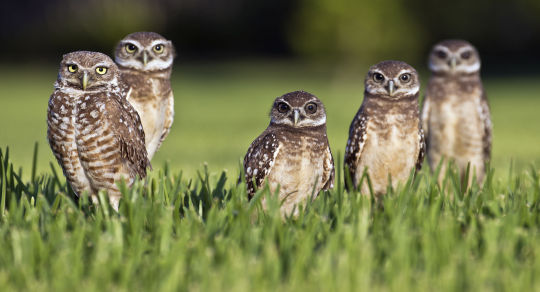
Burrowing Owl, by Travel Way Of Life, CC BY-SA 2.0
PLEASE SUPPORT US ON PATREON. EACH and EVERY DONATION helps to keep this blog running! Any amount, even ONE DOLLAR is APPRECIATED! IF YOU ENJOY THIS CONTENT, please CONSIDER DONATING!
Genus: Athene
Status: Extant
First Described: 1822
Described By: F. Boie
Classification: Dinosauria, Theropoda, Neotheropoda, Averostra, Tetanurae, Orionides, Avetheropoda, Coelurosauria, Tyrannoraptora, Maniraptoriformes, Maniraptora, Pennaraptora, Paraves, Eumaniraptora, Averaptora, Avialae, Euavialae, Avebrevicauda, Pygostylia, Ornithothoraces, Euornithes, Ornithuromorpha, Ornithurae, Neornithes, Neognathae, Neoaves, Inopinaves, Telluraves, Strigiformes, Strigidae
Referred Species: A. brama (Spotted Owlet), A. noctua (Little Owl), A. blewitti (Forest Owlet), A. cunicularia (Burrowing Owl), A. megalopeza, A. veta, A. angelis, A. trinacriae, A. cretensis (Cretan Owl)
Athene is a genus of very small owls that are also quite angry in appearance, and that’s why they get to be featured on birthday week. The genus evolved some time in the very late Miocene of the Neogen, based on fossil evidence - so around 11 million years ago, in the Tortonian age - in Hungary. Many fossil and near-fossil species of Athene are known - including A. megalopeza from the Late Pliocene of Western USA, A. veta from the Early Pleistocene of Poland, A. angelis of the Middle Pleistocene of Corsica, A. trinacriae of the Pleistocene Mallorca, and the Cretan Owl, A. cretensis, which is from the Pleistocene Mediterranean. The Cretan Owl was a flightless member of the species, living on the island of Crete, and it would have been about 60 cm tall. It went extinct, sadly, due to human hunting.
Cretan Owl by Stanton F. Fink, CC BY 2.5
Living members of this genus primarily live in India, though the most famous species, the Burrowing Owl, lives in the Americas. The Burrowing Owl is small, only about 19 to 28 cm long, making them only slightly larger than the American Robin. They have long legs, which are utilized in their Burrowing pursuits, though they are also fast animals. Males and females are fairly similar, with the females being only slightly heavier. They have brown heads and wings, with white chests and brown spotting on their chests. They have very bright eyes and dark yellow or grey beaks. They also look like they’re going to murder you.
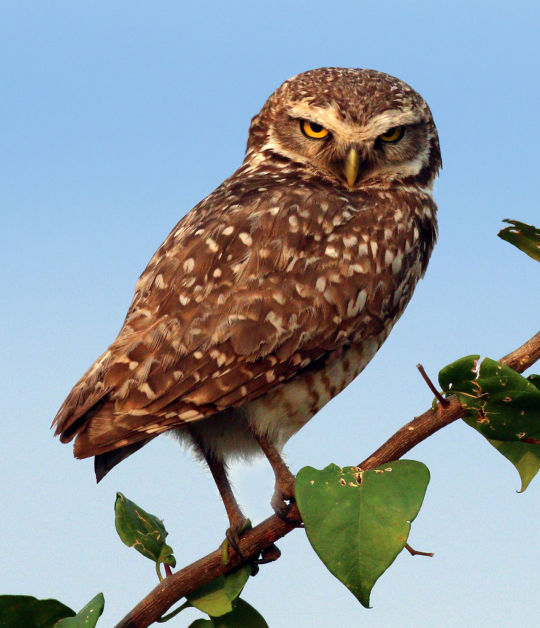
By Charles J. Sharp, CC BY-SA 4.0
Fossil remains specifically of the Burrowing Owl are known from the Bahamas and other locations in Latin America, with most of them becoming extinct due to ecological and sea level changes at the end of the last ice age. They live in the Western United States, portions of Mexico and Florida, and dry areas of South America, and their territory is expanding with increased deforestation. Usually, those birds that live in more Northern locations only stay in those locations for the summer, and then they migrate to the south for the winter. Others that live in warmer locations do so year-long. They nest and roost in burrows made by ground squirrels, and they mimic rattlesnakes - which show a similar behavior - in order to scare off threats. They are a diurnal owl, unlike most other owls.

By Glauxfan, in the Public Domain
Burrowing Owls can live 9 years and even up to 10 in captivity, and are mainly killed by vehicles, badgers, coyotes, and snakes, as well as cats and dogs. They nest in late March or April in North America, and they usually only have one mate, though sometimes males can have two. Pairs of owls will occasionally nest in colonies, usually in open grasslands and prairies, but also places like airports, golf courses, and farms. They nest in underground burrows, which they either find, or dig for themselves. They line their nest with mammal dung and other materials that can control the climate inside the burrow, and eggs are laid every one or two days until 4 to 12 eggs have been laid. These eggs are incubated by the female for three to four weeks while the male brings food, and the parents feed the chicks together. They can begin to make short flights after four weeks and they start to leave the nest at that point, with the parents still helping them for about three months. Sadly, only four to five chicks survive long enough to leave the nest. The owls do, however, in some locations use the same burrow every year, though if they migrate that’s less likely.
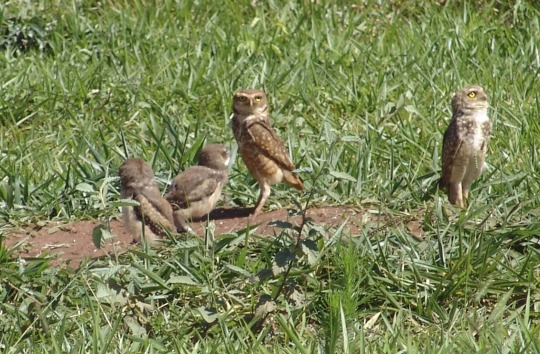
CC BY 2.5
Burrowing Owls hunt by waiting on a perch until they spot prey, swooping down on the prey or flying up to catch insects. They can also chase prey on foot across the ground. They eat many different types of invertebrates and small vertebrates, such as insects and small rodents, as well as some squamates. They are something of a generalist when it comes to insect food, eating everything from katydids and crickets to termites, beetles, and even spiders and millipedes (which aren’t insects but are closely related arthropods). They also occasionally eat fruits and seeds, which is different than other owls. The bird is not considered endangered due it its spread from deforestation, though it is endangered in Canada, threatened in Mexico, and of special concern in most of the USA. It is mostly declining due to loss of habitat and increase of prairie dogs, though they do inhabit human locations. Passive relocation does work to move them, with coercion and enticement used to bring the owls to a new nesting site.

Spotted Owlet, by Lip Kee Yap, CC BY-SA 2.0
The Spotted Owlet, A. brama, lives in India and Southeastern Asia, in open habitats much like its relative. It also has adapted to human environments, similar to the Burrowing Owl. They are small and stocky, only about 21 cm long, with grey-brown feathers and white under-feathers. They lay eggs in holes in trees and buildings, laying only 3 to 5 eggs at a time. They are nocturnal, but often seen during the daytime, bobbing their heads and staring at intruders when disturbed. It hunts insects and small vertebrates, and depending on the location they have shown preferences (such as insects being preferred in Pakistan, whereas rodents are preferred in Jodhpur).
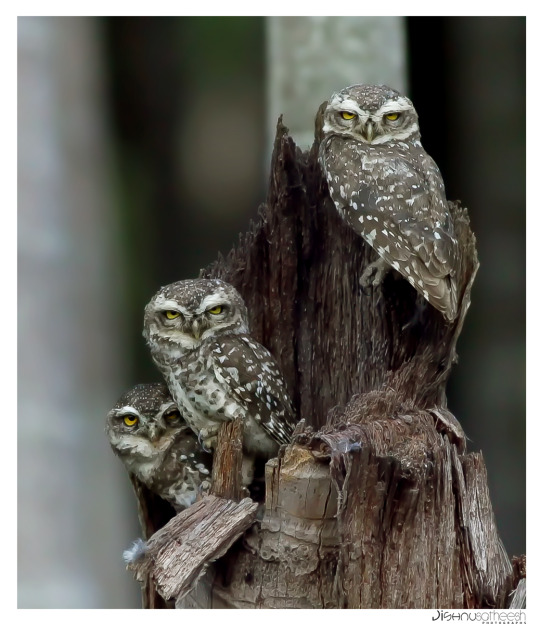
By Jishnu Satheesh Babu, CC BY-SA 3.0
They have a harsh and loud call, beginning chirurr-chirurr-chirurr and ending with chirwak-chirwak, with calls occurring mostly in the dawn or just after sunset. They have a breeding season from November to April, with pairs grasping bills, preening, and feeding each other. The family structure is rather unclear, though males may copulate with many females and females often mating with other females. They nest in cavities, lining the nests with leaves and feathers. They lay about three to four eggs, and they’re incubated as they come out, so the chicks are often a variety of sizes. They feed the young on insects, and later on small vertebrates. Only one or two chicks ever leave the nest, after about 20 to 28 days. They also have a pineal gland, which was thought to be gone in owls.
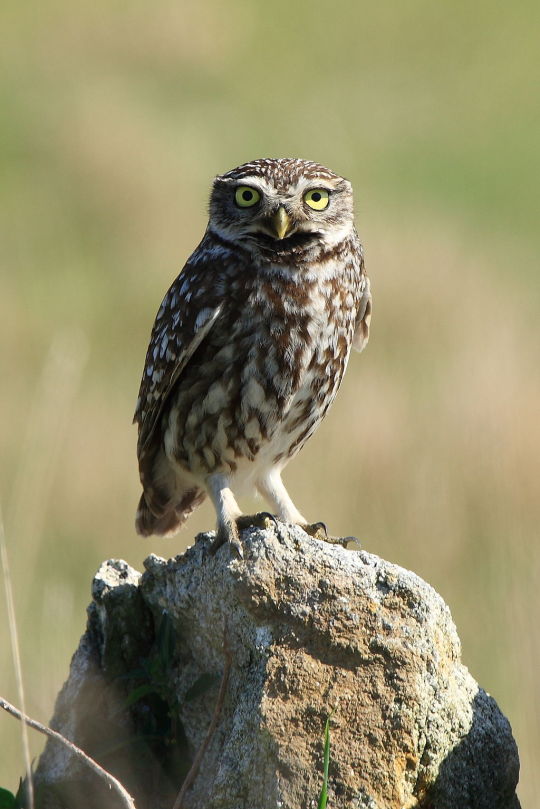
Little Owl, by Arturo Nikolai, CC BY-SA 2.0
The little owl, A. noctua, is from parts of Europe, northern Africa, the Middle East, and central Asia. It is a small, round owl like the other members of its species, with its length only about 22 cm. It is about greyish brown and spotted and streaked both above and underneath. They have a kiew, kiew call, though they can also whistle and trill. They are sedentary and found in open countryside, like the Burrowing Owl, and is often found in villages and suburbs as well. They perch on elevated positions and swoop down to catch small prey, including game birds. They’re also very territorial, with the males remaining in one territory for life, and coming into contact in the spring. They have territorial calls if they encounter one another in their hunting territories, and fly at each other aggressively.
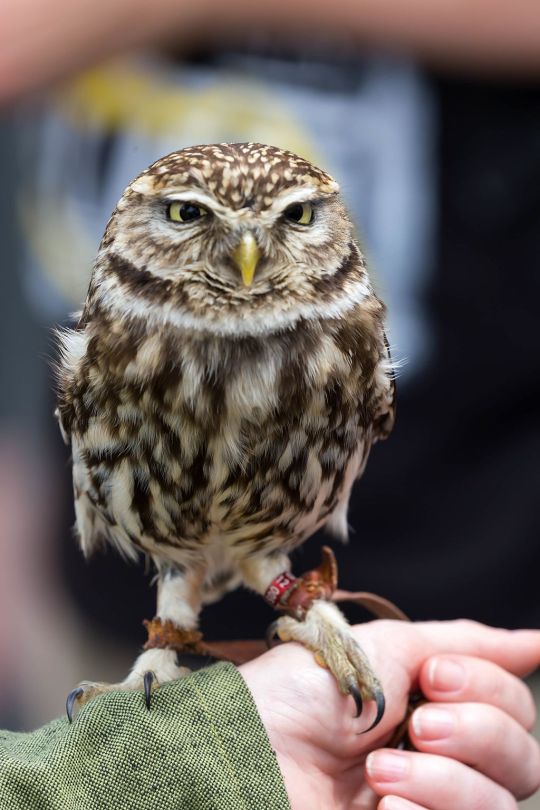
By Marco Verch, CC BY 2.0
If that flight is unsuccessful, the occupier tries to make contact with claws. The owls will drop to the ground and make escapes upon losing. The owls can recognize familiar birds such as neighbours, so they are more aggressive towards unfamiliar birds that wouldn’t normally be around them. They are mostly vocal at night, but they are partially diurnal. During nesting, they can nest in trees, cliffs, quarries, old buildings, and even rabbit burrows, laying clutches of three to five eggs. The female incubates the eggs as the male brings food, and the eggs hatch after 28 to 29 days. The parents will hunt and feed them together, and the young disperse but stay close. The mated pairs stay together for at least a year, but may live together for their whole lives. They live about sixteen years, and can get very used to humans.
By Rasbak, CC BY-SA 3.0
The Little Owl has a large range, and there’s probably between 560k and 1.3mil breeding pairs in Europe, so the global population is probably between five million and fifteen million owls. This population is probably stable, so it is not of concern in conservationist circles. The Little Owl is closely related to the Greek Goddess Athena and the Roman Goddess Minerva, with the owl appearing on coins from 500 BC in Greece. The call of the Owl is said to have heralded the murder of Julius Caesar.

Forest Owlet, by Krishna Khan, CC BY-SA 3.0
The Forest Owlet, A. blewitti, is the last species in this genus, and sadly it is near extinction. It is Critically Endangered and is known from only a few tiny localities in India, which are parts of shrinking forests that are being destroyed by human activity. It is 23 cm long, and stocky, with a large skull and beak. They have fewer spots than the Spotted Owlet and are primarily dark grey-brown, with a white central wedge on its chest. They hunt from perches where they sit still and wait for prey, flicking their tails from side to side when prey is being chased in excitement. They eat mostly lizards, and then some rodents and bird and invertebrates. The males hunt and the females incubate the eggs, with courtship occurring mainly in January to February. They are mostly diurnal, and they bask on tall trees at night. It is losing many of the trees it needs for nesting, which has lead to an extensive decrease in its population, with it estimated that there are only 250 individuals left in the world, since its dense jungles are gone. Individuals are being observed in Wildlife Sanctuaries, including mated pairs.
Sources:
https://en.wikipedia.org/wiki/Cretan_owl
https://en.wikipedia.org/wiki/Athene_(owl)
https://en.wikipedia.org/wiki/Burrowing_owl
https://en.wikipedia.org/wiki/Spotted_owlet
https://en.wikipedia.org/wiki/Little_owl
https://en.wikipedia.org/wiki/Forest_owlet
Guerra, C., P. Bover, J. A. Alcover. 2012. A new species of extinct little owl from the Pleistocene of Mallorca (Balearic Islands). Journal of Ornithology 153 (2): 347 - 354.
Shout out goes to @paukena!
#athene#owl#bird#dinosaur#burrowing owl#little owl#forest owlet#spotted owl#palaeoblr#birblr#athene brama#athene noctua#athene blewitti#athene cunicularia#athene megalopeza#athene veta#athene angelis#athene trinacriae#athene cretensis#paukena#dinosaurs#biology#a dinosaur a day#a-dinosaur-a-day#dinosaur of the day#dinosaur-of-the-day#science#nature#factfile#דינוזאור
103 notes
·
View notes